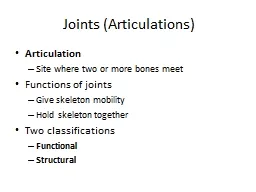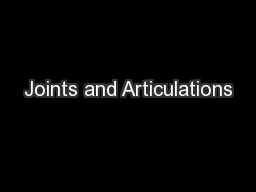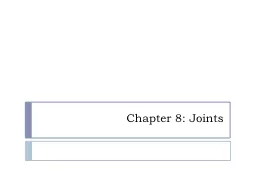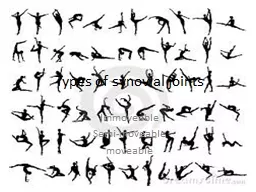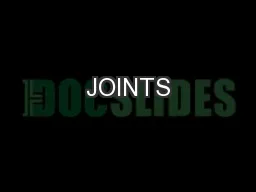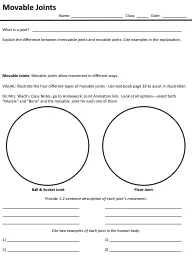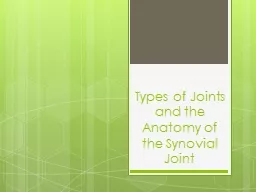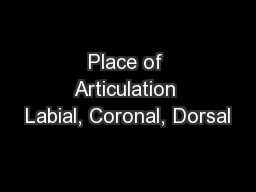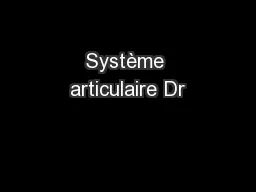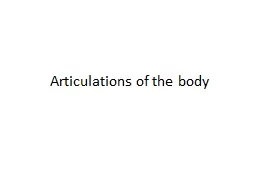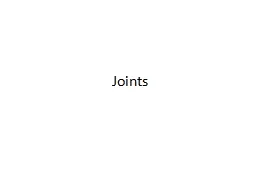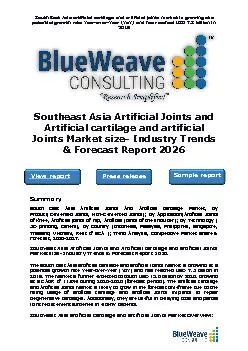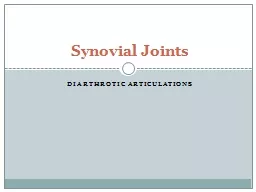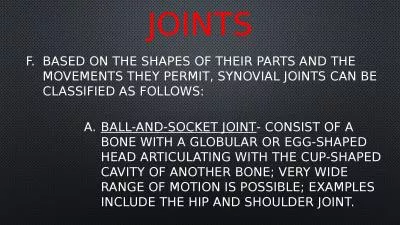PPT-Joints ( Articulations
Author : WheresMyPizza | Published Date : 2022-08-01
Articulation Site where two or more bones meet Functions of joints Give skeleton mobility Hold skeleton together Two classifications Functional Structural Functional
Presentation Embed Code
Download Presentation
Download Presentation The PPT/PDF document "Joints ( Articulations" is the property of its rightful owner. Permission is granted to download and print the materials on this website for personal, non-commercial use only, and to display it on your personal computer provided you do not modify the materials and that you retain all copyright notices contained in the materials. By downloading content from our website, you accept the terms of this agreement.
Joints ( Articulations: Transcript
Articulation Site where two or more bones meet Functions of joints Give skeleton mobility Hold skeleton together Two classifications Functional Structural Functional Classification of Joints . The “Moving” Part of Anatomy!. Introduction. Many major sports, activities and hobbies require us to be able to move around. These movements define us as human because we have a unique ability to move in the animal kingdom. Classify and describe the general structure of a joint. . Classification of Joints. Fibrous – . joined by fibrous tissue; no joint cavity. Mostly immovable. . Cartilaginous- . joined by cartilage; no movement. No movement. . Classification of Joints. Objectives. Define Joint or Articulation. Classify Joints by Structure and by Function. Describe the general structure, know the properties of, and provide examples of fibrous, and cartilaginous joints. Immoveable. Semi-moveable. moveable. Immoveable joints. These joints surround and protect vital body parts.. Skull. Semi-moveable joints. These surround and protect vital organs but can move a little bit.. Objectives. Be . able to classify the joints of the body both structurally and functionally. Be able to . identify example classification of joint. Be able to describe the structure of a synovial joint. Name: . . . Class: . . . Date: . . What is a joint? . . Explain the difference between immovable joints and movable joints. Cite examples in the explanation.. Movable Joints. What is an Articulation (Joint). Point of contact between two bones. **There are three types of joints. 1. Fibrous Joints. Also called “sutures”. These joints are bound tightly together by connective tissue and allows . Place features. What is status of [f] and [Φ]?. [Φ] appears after [a]. [f] appears elsewhere. What is status of [f] and [Φ]?. Minimal pairs?. Complementary or contrastive distribution?. Status of [s] and [ʃ] in English?. Hamzaoui. Laboratoire d’anatomie Blida. DEFINITION. Le système articulaire rassemblent les. moyens par lesquels les os s’unissent les. uns aux autres. . une articulation est l’union de deux ou plusieurs pièces osseuses permettant la mobilité entre ces pièces.. Articulation. – A joint, or point of contact between bones. 3 major categories based on function or structure.. For this class we will focus on structure.. 3 types of joints. Fibrous . Joints with differing amounts of connective tissues. Some of these joints have limited movement but most are fixed and have no movement. A joint is a point of connection . between . two bones. . Strands of connective tissue, . called . ligaments. ,. . hold the bones together . and ensure . the stability of joints. Joint Classification. The South East Asia artificial cartilage and artificial joints market is growing at a potential growth rate Year-over-Year (YoY) and has reached USD 7.3 billion in 2019. The market is further expected to touch USD 15.0 billion by 2026, growing at a CAGR of 11.8% during 2020-2026 (forecast period) Synovial Joints. What are synovial joints?. Freely movable joints. Contain a cavity filled with thick, slippery fluid (Synovial fluid). Found mostly in articulations of the . appendicular. skeleton. Ball-and-socket joint. - consist of a bone with a globular or egg-shaped head articulating with the cup-shaped cavity of another bone; very wide range of motion is possible; examples include the hip and shoulder joint..
Download Document
Here is the link to download the presentation.
"Joints ( Articulations"The content belongs to its owner. You may download and print it for personal use, without modification, and keep all copyright notices. By downloading, you agree to these terms.
Related Documents

